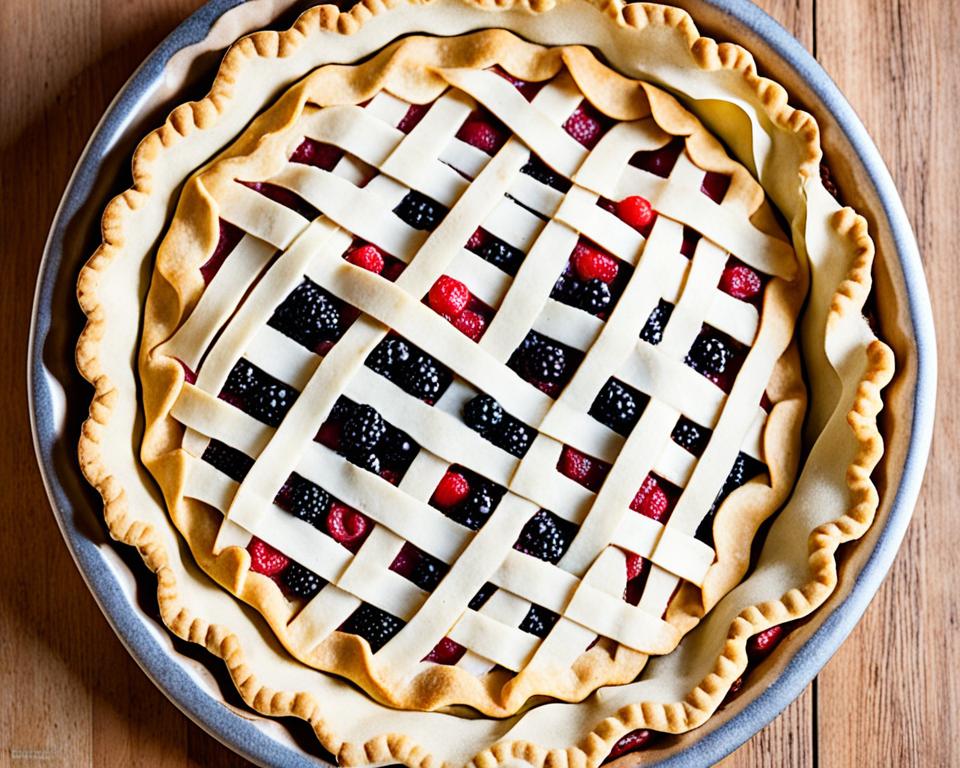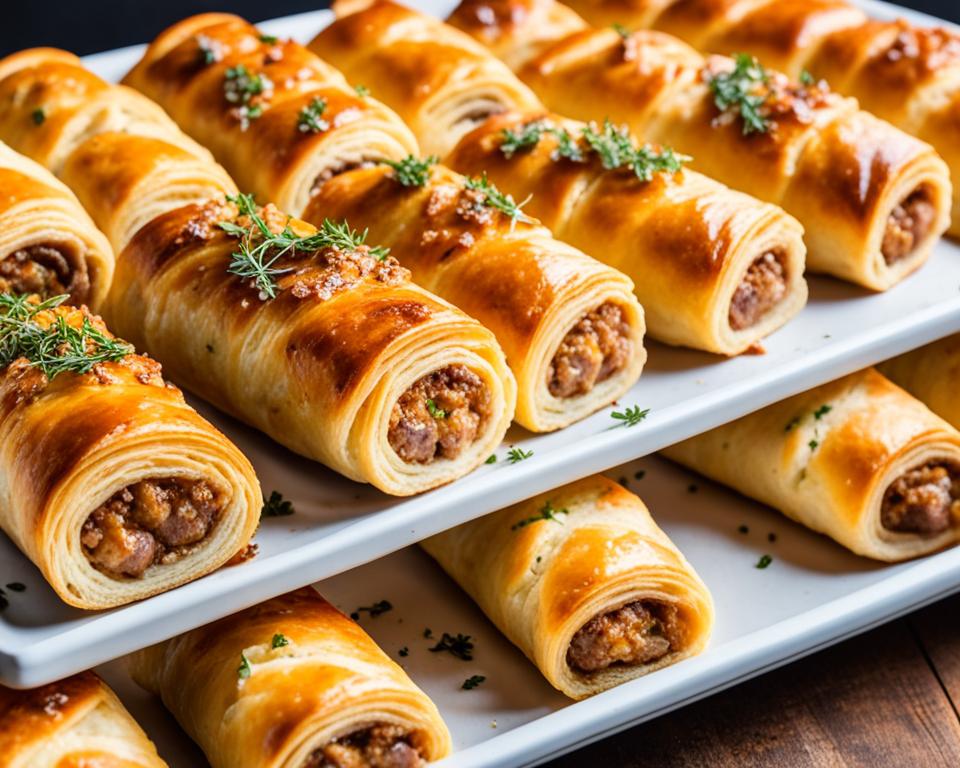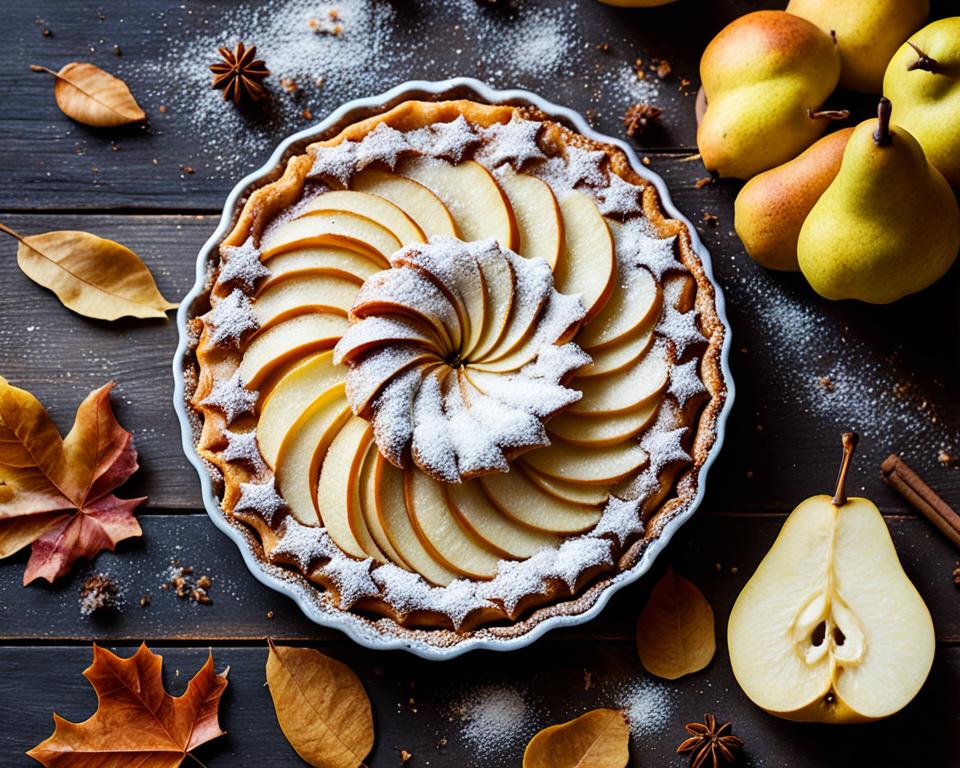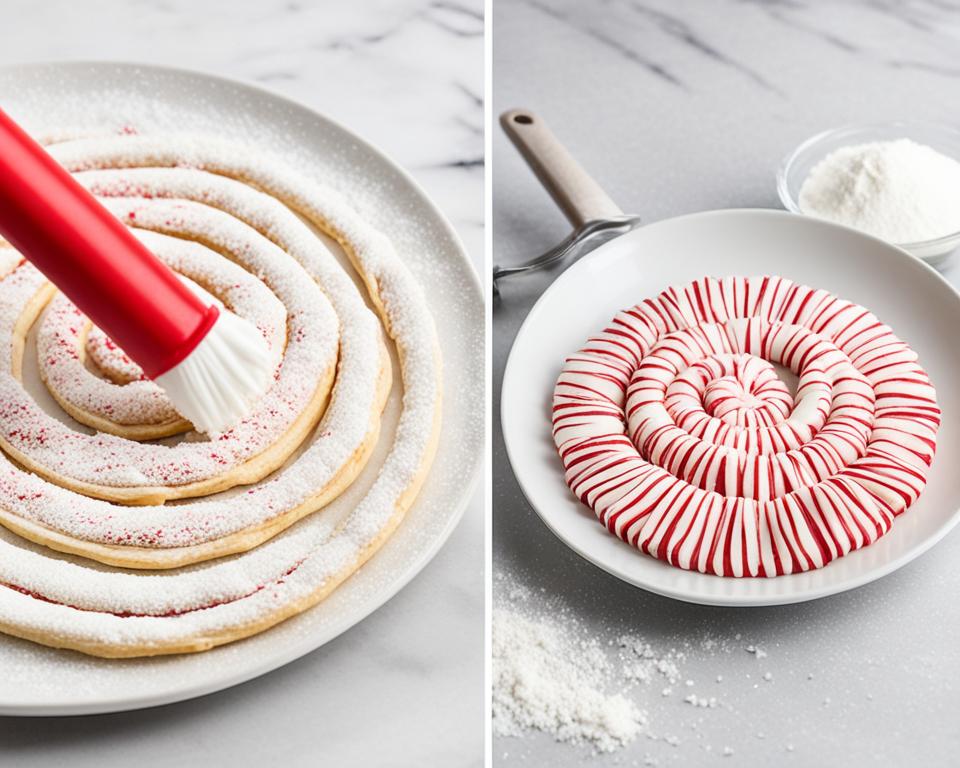Are you tired of struggling to achieve the perfect flaky pie crust? Look no further! In this article, you will discover the secrets and tips to create homemade pie crusts that are buttery, tender, and crisp. Whether you’re a seasoned baker or a beginner, these foolproof techniques will elevate your pie crust game to new heights.
Creating a flaky pie crust is an art, and it all begins with understanding the importance of certain ingredients and techniques. From using cold butter to blind baking, each step plays a crucial role in achieving that sought-after flakiness. So, let’s dive in and uncover the secrets to creating the perfect pie crust, shall we?
Key Takeaways:
- Using cold butter is essential for creating flaky crusts.
- Keeping all ingredients and the dough cold helps maintain the integrity of the crust.
- Blind baking ensures a fully cooked and crisp crust.
- Avoid overworking the dough to prevent tough textures.
- Chilling the dough before rolling contributes to flakiness.
The Importance of Cold Butter
When it comes to creating flaky crusts and perfect pie dough, one of the secret ingredients is cold butter. Cold butter plays a crucial role in achieving the desired texture and taste in your pies. Let’s take a closer look at why cold butter is so important in creating buttery pastry.
When cold butter is incorporated into the pie dough, it creates pockets of fat that melt during baking. These melted pockets result in the formation of layers, giving the crust its signature flakiness. Without cold butter, the dough would be lacking in those delicate layers that make a perfect pie crust.
To ensure that your butter remains cold throughout the process, it is recommended to freeze the butter before incorporating it into the dough. By doing so, you are preserving the cold temperature of the butter, allowing it to create those desirable flaky crusts.
Many experienced bakers swear by the difference using cold butter makes in their pie crusts. It’s a simple yet effective technique that can elevate your pies to the next level. So, the next time you embark on a pie-baking adventure, remember to reach for that cold butter and savor the flaky goodness it brings to your pastry.
Now that you understand the importance of cold butter, let’s delve into the next section where we will explore the significance of keeping all the ingredients and dough cold, ensuring a perfect pie crust every time.
Keeping Ingredients and Dough Cold
In addition to using cold butter, it is essential to keep all the ingredients and the dough as cold as possible. This is a crucial step in creating a flaky pie crust that is buttery, tender, and crispy.
Tips for Keeping Ingredients Cold:
- Place ice cubes in the liquid ingredients, such as water or milk, to keep them chilled throughout the mixing process.
- For recipes that require melted butter, refrigerate it briefly after melting to return it to a colder state before incorporating it into the dough.
- Working with cold ingredients will slow down the melting of the butter, which is crucial for achieving the desired flakiness in the pie crust.
Chilling the Dough:
To ensure the dough remains cold, it is important to chill it before rolling it out.
- After mixing the dough, shape it into a disc or ball and wrap it tightly in plastic wrap.
- Refrigerate the dough for at least 30 minutes or up to overnight.
- The longer the dough chills, the more time the gluten will relax, resulting in a more tender crust.
Using a Chilled Work Surface:
In addition to chilling the dough, it is beneficial to work on a cold surface to prevent the butter from melting too quickly.
“Chilling the work surface, whether it be a countertop or a rolling mat, helps maintain the cold temperature needed to create a flaky pie crust. This method ensures that the dough remains at the optimal temperature for achieving the desired texture.” – Katherine Johnson, Pastry Chef
By maintaining a cold environment during the pie crust preparation, you have a higher chance of achieving the flaky layers and buttery goodness that make a perfect pie crust. So remember to keep your ingredients and dough as cold as possible throughout the process.
The Technique of Blind Baking
Blind baking is a crucial technique that ensures your pie crust turns out perfectly baked, with a flaky texture that will impress everyone. It prevents the crust from becoming soggy, especially when you have a filling with high moisture content. By following the blind baking method, you can avoid the disappointment of cutting into a pie only to find raw dough.
To blind bake your pie crust, start by preparing your raw dough. Roll it out and place it in your pie dish. Then, cover the dough with parchment paper, making sure it covers all the edges. This will protect the crust from direct heat and prevent it from browning too quickly.
Now, it’s time to add pie weights. Pie weights ensure that the crust holds its shape and does not puff up during baking. You can use various options as pie weights, such as ceramic or metal pie weights, dried beans, or even uncooked rice. Gently pour the pie weights into the parchment paper-lined crust, distributing them evenly.
Once your pie weights are in place, it’s time to blind bake the crust. Preheat your oven to the recommended temperature for your specific recipe. Then, carefully transfer the pie dish to the oven and bake the crust for a short period, as instructed in the recipe. Blind baking times can vary depending on the recipe and the type of crust, but typically it’s around 10-15 minutes.
Remember: Blind baking times and temperatures may vary depending on the recipe, so always follow the instructions provided in the recipe you’re working with.
After the initial blind baking time, carefully remove the pie weights by lifting the parchment paper, and return the crust to the oven to finish baking. This allows the crust to cook evenly and develop a beautiful golden-brown color.
Once your pie crust is perfectly baked, remove it from the oven and let it cool before adding your desired filling. The blind baking technique ensures that your crust is fully cooked, flaky, and ready to hold your delicious pie filling.

Blind baking is a game-changer when it comes to creating tender pie crusts with a flaky texture. This technique allows you to enjoy pies with delicious fillings and perfectly baked crusts every time.
Avoid Overworking the Dough
When it comes to making the perfect flaky pie crust, one of the biggest mistakes you can make is overworking the dough. This can lead to the development of gluten, resulting in a tough and rubbery texture that no one wants in their pie.
Gluten is a protein that forms when flour is combined with liquid and worked vigorously. It gives structure and elasticity to baked goods, but in the case of pie crust, we want to avoid excessive gluten development.
To ensure a tender and flaky crust, it is crucial to handle the dough with care. Mix the ingredients until just incorporated, being careful not to overmix. The dough should come together easily and have a slightly crumbly texture.
Remember: Less is more when it comes to mixing pie dough. The goal is to create a dough that will hold together without developing too much gluten.
The Importance of Chilling the Dough
When it comes to creating a flaky crust, chilling the pie dough before rolling it is an essential step. By ensuring the dough stays cold, you set the foundation for achieving the perfect flakiness and tenderness in your crust. Chilling the dough has a significant impact on the final texture and structure of your pie, making it a crucial technique to master.
When the dough is chilled, the cold butter remains solid, and it gradually melts during baking. This slow melting process creates steam, which creates pockets of air in the dough. These air pockets are what give your crust its flaky texture. If the butter melts too quickly, the steam will escape, resulting in a dense and heavy crust.
In addition to preserving the butter’s integrity, chilling the dough also helps maintain the layers created during the process of incorporating the fat into the flour. When cold, the fat (usually butter or shortening) is distributed into the dough in pea-sized pieces. These fat pockets will melt during baking, leaving behind empty spaces that contribute to the tender and flaky crust.
By prioritizing the chilling process, you allow the dough to rest and relax, giving it time to fully hydrate and absorb the liquid ingredients. This hydration is crucial for developing the dough’s structure and helps prevent a tough and dry crust.
To chill the dough effectively, shape it into a disk, wrap it tightly in plastic wrap, and refrigerate for at least 30 minutes, or up to 24 hours. This resting time allows the gluten to relax and ensures your dough is in optimal condition for rolling.
Remember, while chilling the dough is a critical step, it’s equally important not to overchill it. If the dough becomes too cold and hard, it can be difficult to roll out and may lead to uneven thickness and cracking. Therefore, it’s crucial to find the right balance and monitor the dough’s temperature throughout the chilling process.
Tips for Chilling the Dough:
- Shape the dough into a disk before chilling to ensure the most efficient cooling process.
- Wrap the dough tightly in plastic wrap to prevent any air exposure that could dry it out.
- Refrigerate the dough for at least 30 minutes before rolling, allowing it to rest and hydrate.
- Monitor the dough’s temperature to prevent it from becoming too cold or too warm.
By understanding and implementing the importance of chilling the dough, you can ensure your pie crust turns out flaky, tender, and absolutely delicious.
Additional Tips and Alternatives
In addition to the previously mentioned tips, there are a few more suggestions for achieving the perfect flaky pie crust.
- Try Vinegar in Pie Dough: Some bakers swear by adding vinegar to their pie dough to improve flakiness. The acidity of the vinegar helps tenderize the dough, resulting in a light and delicate crust.
- Consider Vodka in Pie Crust: Another alternative to enhance flakiness is using vodka in the pie crust recipe. Vodka doesn’t contribute to gluten formation like water does, resulting in a more tender and flaky texture.
“Adding vinegar or vodka to your pie dough can be game-changers when it comes to achieving the perfect flaky crust. Don’t be afraid to experiment and see which alternative works best for you!”
These alternatives have been tried and tested by many bakers and are worth exploring for those seeking foolproof ways to achieve flakiness in their pie crusts.
| Pie Crust Tips | Benefits |
|---|---|
| Use cold butter | Creates layers of fat for a flaky texture |
| Keep ingredients and dough cold | Prevents butter from melting too quickly and ensures flakiness |
| Blind bake the crust | Prevents the crust from becoming soggy |
| Avoid overworking the dough | Prevents gluten formation and maintains tenderness |
| Chill the dough before rolling | Maintains cold butter and enhances flakiness |
| Add vinegar or vodka | Improves flakiness and tenderness |
By incorporating these tips and exploring alternative ingredients, you can elevate your pie crust game and achieve the perfect flaky texture you desire.
Conclusion
Creating the perfect flaky pie crust may seem challenging, but with the right techniques and tips, it is achievable. By using cold ingredients, properly chilling the dough, and avoiding overworking it, you can create a flaky, buttery, and tender crust that will enhance any pie. Tips like blind baking and the addition of vinegar or vodka can further enhance the flakiness. Experimenting with these techniques will help you master the art of pie crust and elevate your baking skills.
Additional Pie Recipes and Final Thoughts
In addition to the tips and techniques provided for creating the perfect flaky pie crust, there are countless pie recipes available to explore. Let your creativity flow and experiment with different fillings to find the perfect combination that satisfies your taste buds.
Whether you’re a fan of classic fruit pies like apple or cherry, or you prefer indulging in creamy custard pies such as banana cream or key lime, the options are endless. You can even delve into the realm of savory pies like chicken pot pie or quiche for a delightful twist.
Pairing a perfectly flaky crust with a delicious filling is the key to creating a show-stopping dessert. Don’t be afraid to try new flavors and add your own twist to traditional recipes. Remember, the crust is just as important as the filling, so be sure to master the techniques for creating a tender and flaky crust.
Armed with the knowledge of pie-making tips and the excitement of exploring various pie crust recipes and fillings, you can become a true master pie-maker. So put on your apron, gather your ingredients, and embark on a culinary adventure that will delight your family and friends. Enjoy the process of creating delectable pies that will leave everyone wanting more. Happy baking!
FAQ
What is the key to achieving a flaky pie crust?
The key to achieving a flaky pie crust is using cold butter.
Why is it important to keep all the ingredients and dough cold?
Keeping all the ingredients and dough cold helps prevent the butter from melting too quickly and ensures the creation of flaky layers in the pie crust.
What is blind baking, and why is it necessary?
Blind baking is a technique where the pie crust is pre-baked without the filling. It is necessary to prevent the crust from becoming soggy and ensure that it is fully cooked.
Why should I avoid overworking the dough?
Overworking the dough can lead to the development of gluten, resulting in a tough and rubbery texture in the pie crust.
How does chilling the dough before rolling it contribute to a flaky crust?
Chilling the dough before rolling it helps keep the butter cold, which is crucial for achieving flakiness and maintaining the integrity of the layers in the crust.
Are there any additional tips for creating a perfect flaky pie crust?
Yes, some additional tips include adding vinegar or vodka to the pie dough to improve flakiness, blind baking the crust, and using a combination of cold ingredients and a chilled work surface.
What is the secret to the perfect flaky pie crust?
The secret to the perfect flaky pie crust lies in using cold butter, keeping all the ingredients and dough cold, blind baking the crust, avoiding overworking the dough, chilling the dough before rolling, and experimenting with tips like adding vinegar or vodka to the dough.
Are there any additional pie recipes available?
Yes, there are countless pie recipes available to explore. Pairing a perfectly flaky crust with a delicious filling can create a show-stopping dessert.
What are the benefits of mastering the art of pie crust making?
By mastering the art of pie crust making, you can elevate your baking skills and enjoy the process of creating delectable pies for yourself and your loved ones.





